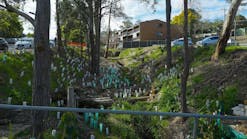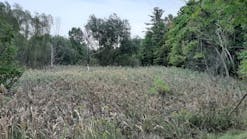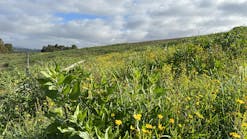Engineers and contractors who work with such manmade materials as steel and concrete have a simpler life than those who choose to work with soil and rock. Every slope stabilization project is unique, whether it is designing an engineered cut for new construction or remediating a catastrophic slope failure that occurred overnight.
Near the end of the 19th century, five bachelors homesteaded an isolated valley in Colorado’s Rocky Mountains. This valley came to be called, naturally enough, Bachelor Gulch. The homesteaders were surely unaware that the surrounding mountains would develop into an area of popular ski resorts and upscale homes.
Located near Vail, CO, between Beaver Creek Resort and Arrowhead, Bachelor Gulch Village is a private residential community of condominiums, townhouses, cluster homes, and single-family residences covering an area of 1,400 ac., including 200 ac. of ski terrain. The village was planned as a small, intimate development with ski-in and ski-out access.
Building in such an area presents obvious construction problems that result from the steep slopes of the residential lots. Less obvious problems result from strict controls on development within the village. Development is guided by a master plan that is designed to maximize views and privacy. An architectural board dictates all aspects of design and construction. Retaining walls are commonly used to maximize the available building area on small, steep lots. Walls in the development are usually constructed of cantilevered concrete and faced with moss rock. The typical pattern uses rectangular rocks to give the appearance of a mortarless dry stack.
The traditional construction method was not feasible on Lot 78. The lot owner wanted a level building pad on the property, which is located below the main highway that runs through the village. To excavate a level pad within the small building envelope, a 28-ft.-high cut would have to be made immediately below the roadway. It was believed that an unstabilized excavation would fail before construction of a traditional retaining wall was complete.
The owner contracted with Yenter Companies of Arvada, CO, for construction of the cut and the retaining wall. A traditional concrete or reinforced soil wall 28 ft. high would have had a width of 14 ft. or greater. This would have substantially reduced the available building area on an already-small construction envelope. Pile and lagging was considered as another alternative, but the cost was too high, and this technique would have been limited by the small area that was available for construction.
Yenter instead selected an economical and technically feasible solution that used top-down excavation with the application of soil nails and shotcrete for stabilization. This manner of construction is usually accomplished by bench cutting to a specified nailing layer depth, shotcreting the exposed soil, and then installing the nails before cutting to the next depth. The result is a design that transfers resisting tensile forces from the soil nails into the ground by the creation of friction at the soil-to-nail interfaces.
At Lot 78, the cut was initiated immediately below the guardrail off the highway that runs above the property. The 28-ft. cut was excavated vertically in 8-ft. lifts, and the soil nails and shotcrete were installed in 8-ft. increments. Yenter used 30-ft.-long soil nails placed on 4-ft. centers. This provides a high margin of safety, which is necessary for a residence built below the village’s main highway. For aesthetics, the shotcrete was faced with dry stacked rock to resemble the other retaining walls in the development.
Yenter’s Bob Barrett reports that the total cost was much less than it would have been with any other method of achieving a level platform and constructing a rock wall under these site conditions. The construction time was also greatly reduced, and the space required was less than for traditional methods. As built, the wall has a base thickness of only 4 ft., which provides the homeowner with 10 ft. of valuable building space beyond what would have been provided with traditional construction methods.
According to Barrett, this project demonstrates that “reinforced soils will be a much more important tool for geotechnical engineers to solve problems in the 21st century.” He also notes, “This method for building a reinforced soil wall utilizes open-graded gravel and can be built at any time of the year and in any climate-another huge advantage in climates such as the Rocky Mountains.”
When Amtrak decided to expand operations at its Sunnyside Yard in Queens, NY, the plans included a 9- to 12-ft. cut in a slope at the yard. A retaining wall was needed to stabilize the cut. The subsurface conditions at the site were consistent with those previously encountered in the area. The soils at the site were typical of the Atlantic Coastal Plain, having formed in glacial, postglacial, and marine environments. The predominant soil type encountered during geotechnical testing was a fine-to-coarse sand with varying amounts of gravel and occasional clay layers.
Don del Nero, a geotechnical engineer with Parsons Engineering Science in Atlanta, GA, conducted a retaining wall analysis to identify the best solution for stabilizing the cut. “Because the site was fairly typical for the area,” he says, “we were able to start with a simple, straightforward design and refine it for the site conditions.”
The retaining wall that del Nero analyzed consisted of steel-H soldier piles combined with precast concrete lagging for the wall face. The use of geosynthetic reinforcement was also considered. The initial approach consisted of horizontal layers of geogrid that would be connected to the back face of the concrete lagging.
The analysis evaluated both internal stability and external stability. The internal stability analysis considered the effectiveness of the geosynthetic reinforcement in holding the reinforced soil mass together. Ideally, the geosynthetic reinforcement would cause the soil and the geosynthetic layers to function together as a single monolithic block. This analysis determined the minimum strength needed for the geogrid layers, as well as their number and vertical spacing.
The external stability analysis examined the slip circle depth at the base of the wall. This provided the minimum depth that would be required for the soldier-pile penetration. To be effective, the soldier piles must extend below the failure surface that is predicted by the external stability, or global, analysis.
The retaining wall analysis showed that geogrid reinforcement would indeed be required to maintain the stability of the wall. Geogrid products are generally composed of high-density polyethylene or similar material woven into a sheet to be used as soil reinforcement. Geogrid soil reinforcement is laid horizontally on compacted backfill and is typically connected to the wall-face material by hooking it over pins in the wall.
The height of the Sunnyside Yard retaining wall varies along its length, so two different configurations were developed from the evaluation: one for the minimum 9-ft. height and the other for the maximum 12-ft. height. At the minimum wall height, three geogrid layers were found to be necessary, with placement at depths of 3.5, 5.5, and 7.5 ft. below the tops of the soldier piles. Four geogrid layers were determined to be necessary at the maximum wall height, with placement at 4, 6, 8, and 10 ft. below the tops of the soldier piles.
An alternative design was presented in which lightweight backfill could be used in place of the geogrid panels. Examples of such backfill include expanded polystyrene blocks or lightweight aggregate such as Pennlight, which is used by the Pennsylvania Department of Transportation. The Pennlight material is a hardened form of clay and anthracite that is obtained from coal-mining operations.
Additional requirements for the retaining wall included the use of a geocomposite vertical drain to maintain free drainage of the backfill material. A pipe trench at the base of the wall would carry drain water away from the base of the wall. These drainage materials were recommended in order to reduce the risk of the drainage layer becoming clogged from the washout of fines in the backfill.
Instead of hooking the geogrid over pins, the specified connection between the geogrid and the soldier piles consisted of a steel-channel section bolted to the precast lagging panels. The geogrid was wrapped around the steel channel before the channel was connected to the lagging panel. The geogrid causes the panels to be in tension at their back face rather than at their front face. Therefore, special consideration had to be given to reinforcement of the lagging panels at the connection locations.
Everyone knows the severity of California’s disasters. Droughts are followed by forest fires, which are followed by heavy rains. Throw in the occasional earthquake, and it is no surprise that the state experiences many landslides and other slope-stability problems. To the casual observer, these forces are the cause of many California slope failures. To a professional geologist or engineer, however, these are only the final events causing a slope failure.
David W. Bieber, a registered professional geologist in California, explains that the state’s slides are actually the natural result of the area’s geomorphic conditions. “The principal geomorphic process in California is mass wasting,” says Bieber. The final result of mass wasting is the movement of material downslope.
Bieber has firsthand experience with the ultimate result of mass wasting. In January 1997, three slides developed on a Sierra Nevada canyon slope along a section of US Highway 50, known as Ice House Road. Bieber, who now works with T N & Associates Inc. in Rancho Cordova, CA, was involved in the remediation of the three slides. Although the slides were all in the same general vicinity, each required a different approach to stabilization.The first slide, described as a joint plane failure, began above Icehouse Road and destroyed part of the roadway as the slope failed. To remediate the slide, the area above the road was first bulldozed to competent bedrock. Five-ft.-high benches were then constructed. As part of the straightforward repair work, layers of geotextile fabric were incorporated into the fill by laying geogrid horizontally on the top of each bench. Bieber describes the fill as a fairly granular select material, so drains were not needed. After the slope was repaired, the roadway was rebuilt and a riprap face was laid on the final 1.5:1 slope.
The second landslide was characterized as a liquefaction-induced movement. A 16-in. culvert running beneath the roadway had become clogged with debris, blocking the flow of water. The water that backed up saturated the soil beneath the roadway, which liquefied and created a debris flow that dropped a section of the roadway.
This slide occurred immediately above the American River. Remediation was made more difficult because the contractor could not allow any of the slide material to fall down the very steep slope into the river, and extremely rigorous requirements were established for monitoring the river.
The slide was repaired by building up the slope with Hilfiker baskets. The Hilfiker baskets are 16- x 8-ft. panels, with the last 4 ft. of material bent up to give the panel an “L” shape. The slope was cut down 30 ft., and a layer of baskets was placed along the lowermost bench. Granular fill material was placed to within approximately 4 ft. of the slope face. A coarser material composed of 4-in. rock was placed up to the final face of the slope. Construction continued by building benches of Hilfiker baskets and fill on top of one another. The layers were wired together, connecting the baskets to one another.
The resulting face had an 80% slope. Twelve in. of aggregate were placed on the uppermost bench, and the roadway was reconstructed over the aggregate base. The new fill material is self-draining, which eliminates the need for manufactured drains. A larger-diameter culvert was used to replace the previous one in the hopes of eliminating future clogging.
The third slide in this area occurred at the top of Cleveland Corral. The slide is now heavily monitored with instrumentation installed by the United States Geological Survey in cooperation with the Eldorado National Forest. This slide reportedly resulted from a deeply rooted bedding-plane failure.
The Cleveland Corral slide was stabilized using a combination of geotextiles, curtain drains, and downdrains. Stabilization began by excavating 5-ft.-high x 10-ft.-deep benches down to stable bed material. A layer of erosion control fabric was placed on the top of each bench, and a curtain drain was installed at the back of each bench. The curtain drains were installed to wick away moisture from the backs of the benches and to transport the moisture to the downdrains. Fill material was placed over the benches and compacted. The roadway was then rebuilt over the repaired slide area.
A one-story addition to the Mount Royal Towers Assisted Living Facility in Birmingham, AL, required the construction of a 45-ft.-tall, 350-ft.-long retaining wall. Backfill material to be placed behind this wall would support the new construction, which had a footprint extending to within 6 ft. of the top of the wall.
A gabion-faced reinforced soil wall was selected for the project. This selection was in part a result of using locally available backfill material and the need for a short construction time. The wall was constructed on a foundation of hard rock composed of gray, unweathered sandstone and shale. Welded-wire gabion baskets with 3-in.2 mesh openings were filled with 1,300 yd.3 of 4- to 8-in. limestone. The fronts of the baskets were handfilled with the larger-size rock to enhance the appearance of the final wall.
The welded-wire bottoms and tops of the gabion baskets extended into the backfill and were tied to soil reinforcements using 3-ft.-long, 12-gauge PVC-coated-wire spiral binders with a 3-in. pitch. The soil reinforcements were 6 ft. in width, with lengths varying from 6 to 33 ft., depending on their vertical position within the backfill. Spiral binders were also used to tie these soil reinforcements together to form a continuous sheet of reinforcement that extended into the soil backfill.The backfill material consisted of a clayey, cherty sand that was compacted with a sheepsfoot roller to 98% of the standard proctor maximum dry density and to within +/-2% of optimum moisture content. The effective cohesion of the backfill was determined from triaxial tests to be 486.5 lb./in.2 with a 43º effective angle of internal friction.
George Ragazzo of Modular Gabion Systems reports that using continuous, jointless gabions and spiral binders in this project significantly increased the wall’s structural strength and significantly decreased the construction time. Ragazzo is general manager of the Mobile, AL, company that supplied the welded-wire mesh, spirals, and lacing wire that were used in the wall construction.
The gabion baskets and wire-mesh reinforcement were manufactured of galvanized, PVC-coated, 12-gauge wire. Modular Gabion Systems touts the long-term reliability of the PVC coating, citing a successful 30-year track record in harsh environments that include salt-water cooling towers and North Atlantic lobster traps. The wire has also been tested to bidirectional tensile loads of 3,076 lb./lin. ft. with a yield stress of 43.5 tons/in.2
As constructed, this massive wall has a verticaldistance between gabion baskets of 18 in. over the lower 18 ft. of the wall and 36 in. over the remainder. The face has a 4.8-degree batter that results from a 3-in. setback on the 36-in. gabions.
Rio Grande de Loiza, Puerto Rico
Gabions were also selected for use on a slope stabilization project in Trujillo, PR, where the US Department of Agriculture used them in combination with wire-mesh-reinforced Pec-Mat for slope protection. The slope stabilization project was located along a portion of the left descending bank of the Rio Grande de Loiza near San Juan.
A 16-ft.-high retaining wall was constructed of gabion material that was supplied in roll-stock form. The PVC-coated, galvanized wire mesh was supplied by Modular Gabion Systems in rolls with various widths and up to 300 ft. in length.
The long rolls allowed the construction contractor to form continuous gabions in the field with widths up to 300 ft. Ragazzo reports that the production of jointless gabions at the construction site provided significant time and cost savings over the use of preformed gabions.
The slope behind the gabion retaining wall supported residential buildings, so it was critical that it be protected from erosion or other forms of failure. Pec-Mat, a turf reinforcement mat manufactured by Greenstreak Inc. in St. Louis, MO, was installed on the slope to provide partial protection. Pec-Mat has a dense web design and is made from thermally welded PVC monofilaments. The material is used to protect seed and topsoil during germination, but its long life also provides long-term soil protection.
On the Rio Grande de Loiza bank, the Pec-Mat was covered by mesh wire for additional slope stability. The reinforcement mesh was constructed of galvanized wire with a 1.5- x 3-in. mesh opening. The Pec-Mat and reinforcement mesh both were stapled into place, and the slope was vegetated.
The construction methods and materials chosen for these wide-ranging solutions to difficult slope-stability problems might not have been the only available choice in each case, but each selection took into account the common concern for long-term, cost-effective solutions. Outside factors, such as aesthetics, environmental concerns, and the need for expeditious construction, were additional considerations for many projects. These are the same concerns facing every professional involved in slope remediation or construction.





